and the distribution of digital products.
Stacks Q4 2024 Brief
- Stacks saw increases in various metrics, including network revenue in USD (+117.95%), daily active addresses (+62.47%), miner participation (+35.23%), miner revenue in USD (+32.45%), daily transactions (+27.36%), TVL (+15.59%), and stacking participation (+3.40%).
- In contrast, Stacks experienced declines in daily net stack (-21.76%), token price (-16.80%), and market cap (-9.50%).
- Two SIPs were approved: SIP-028 established sBTC signer criteria, enhancing secure BTC transfers, and SIP-029 revised the STX emissions schedule to align with Bitcoin’s halving cycle.
- The Nakamoto upgrade, activated on Oct. 28, 2024, improved Bitcoin finality, block production, and security, while sBTC mainnet launched on Dec. 17, 2024.
- Other developments include Grayscale recognizing Stacks as a key Bitcoin scaling solution, CoinFlip announcing sBTC and STX support at global ATMs, and the Stacks.js v7 update, among others.
Stacks (STX) is a Bitcoin Layer-2 (L2) that allows smart contracts and decentralized applications to use Bitcoin as a secure base layer. Transactions are executed on Stacks and settled on Bitcoin, leveraging Bitcoin's security and capital while offering arbitrary programmability that is not possible on its scriptable settlement layer.
Stacks has knowledge of the full Bitcoin state, thanks to its Proof-of-Transfer (PoX) consensus mechanism and Clarity programming language, allowing it to read from Bitcoin at any time. With PoX, miners commit BTC to eligible Stacks addresses that participate in consensus. This process of STX tokenholders participating in consensus and earning BTC from miners is known as Stacking. PoX runs parallel to Bitcoin’s Proof-of-Work (PoW) consensus, hashing and settling Stacks transactions on Bitcoin. Metadata from newly mined Stacks blocks are anchored to every Bitcoin block, allowing users to verify the canonical Stacks blockchain via Bitcoin blocks.
The new Nakamoto upgrade strengthens Stacks’ integration with Bitcoin by (i) introducing sBTC, a decentralized tokenized BTC, (ii) enabling faster block production, (iii) improving Bitcoin finality, and (iv) reducing the chances of Maximal Extractable Value (MEV) exploitation.
Website / X (Twitter) / Discord
Key Metrics Performance AnalysisMarket Cap and Price
Performance AnalysisMarket Cap and Price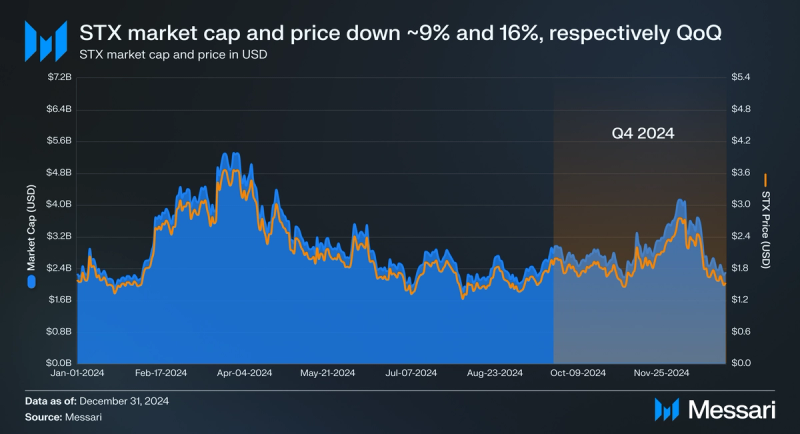
Relative to BTC and ETH benchmarks, which saw their market caps grow ~48.00% and ~28.30% QoQ, respectively – Stacks' market cap declined ~9.50% QoQ to ~$2.31 billion from ~$2.75 billion. This drop led to a fall in market cap rank from 43 in Q3 to 51 in Q4, indicating a weaker position within the broader crypto market. STX's price similarly decreased ~16.80% QoQ to ~$1.53 from ~$1.84. However, on a YoY basis, Stacks' price and market cap are still up ~2.23% and ~7.74%, respectively, reflecting longer-term resilience despite recent quarterly setbacks.
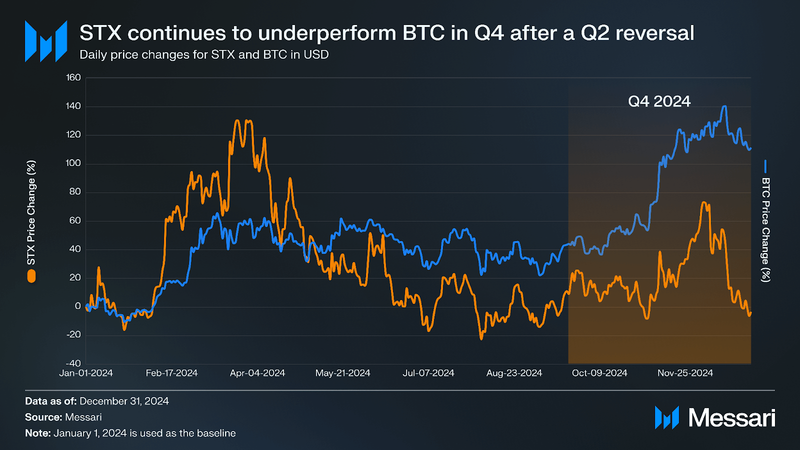
As a Bitcoin L2, Stacks is deeply integrated with Bitcoin not only through its technical framework, but also in its market performance. In early 2024, STX deviated from BTC’s price trajectory, growing ~130.06%, outpacing BTC’s ~61.45% growth in the same period.
This trend reversed in Q2 and Q3, where by the end of Q3, BTC had gained ~43.00% since Jan. 1, 2024, while STX only increased ~16.00% over the same period. This trend persisted into Q4, where BTC accelerated to ~111.35% YTD, while STX fell into negative territory, down ~3.48% YTD.
Revenue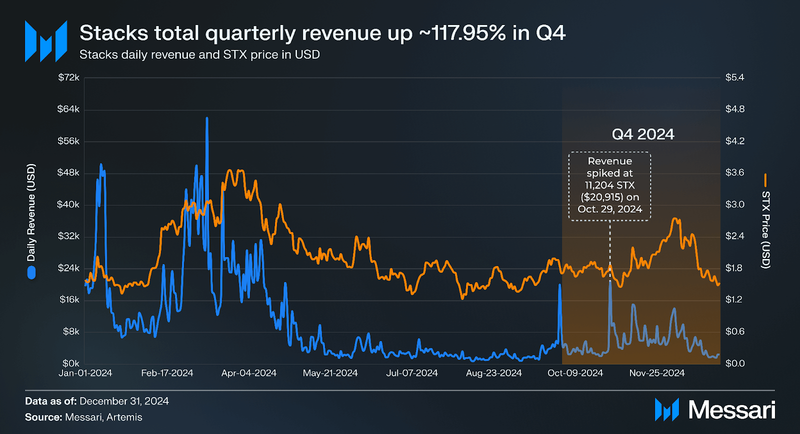
Stacks revenue is measured as total transaction fees and is distributed to Miners through Stacks’ PoX mechanism (along with the coinbase reward, i.e., issuance).
Revenue experienced significant volatility throughout 2024 but showed a notable recovery in Q4 after declining in Q2 and Q3. Specifically, total revenue increased ~85.83% in native STX terms to ~260,252 STX from ~140,047 STX in Q3, and ~117.95% in USD terms to ~$510,824 from ~$234,380 in Q3. This rebound was likely driven by the successful Nakamoto upgrade on Oct. 28, 2024, with a notable revenue spike occurring on Oct. 29, 2024, right after the activation.
Despite these gains, YoY performance still lags behind 2023 levels, with revenue in STX terms down ~57.29% and in USD terms down ~36.15%. This suggests that sustained adoption and ecosystem growth will be necessary for full recovery.
Usage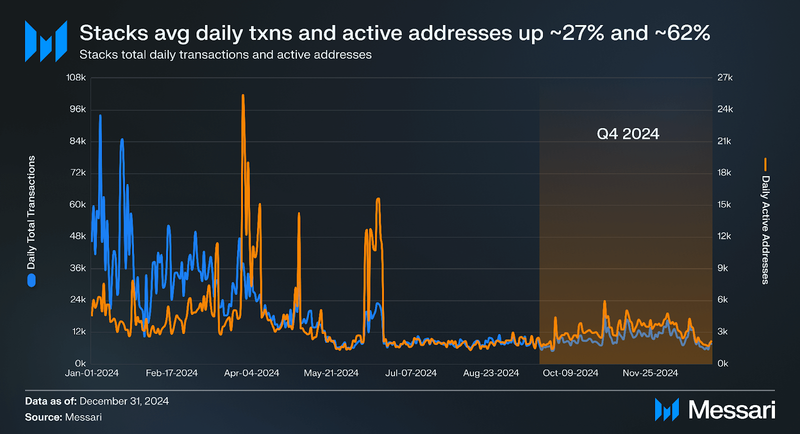
Similar to the recovery in revenue, Stacks saw both average daily active addresses and transactions continue positive trends from Q3.
Average daily transactions rose ~27.36% QoQ, climbing from ~7,938 to ~10,110. Despite this QoQ improvement, transactions remain ~23.41% lower than Q4 2023. Average daily active addresses increased ~62.47% QoQ, rising from ~2,001 to ~3,251 while also up ~72.29% YoY, reflecting a gradual but steady recovery in network activity.
These metrics highlight that although the ecosystem experienced a downturn earlier in the year, recent protocol advancements (e.g., the Nakamoto upgrade and the release of sBTC) have reinvigorated user participation and transaction volumes on Stacks.
Total Value Locked (TVL)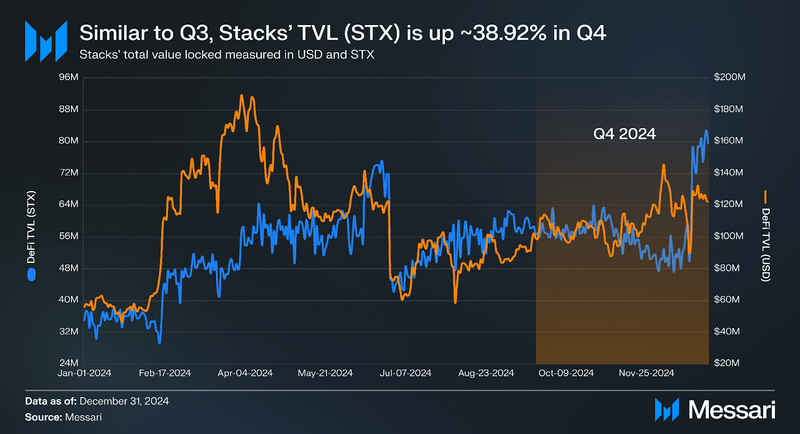
Stacks' total value locked (TVL) continued its upward trend from Q3 into Q4, showing growth in both USD and native STX terms. Specifically, TVL in USD terms increased ~15.59% QoQ, up ~121.88% YoY, and in STX terms, TVL rose ~38.93% QoQ, up ~117.04% YoY – overall, reflecting increased ecosystem resilience and participation.
Stacking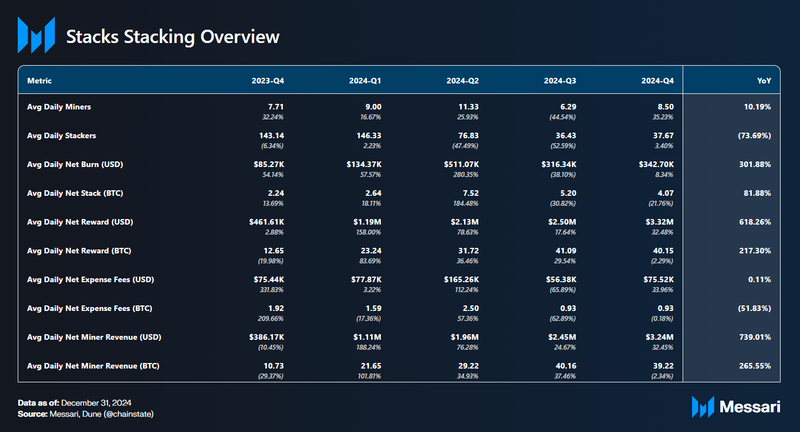
Stacking, similar to mining on Bitcoin, is largely dominated by pools. Because of this, one should keep in mind that the number of participants across decentralized and custodial stacking pools is considerably lower when counted as unique Stackers. It is impossible to know how many participants are in the custodial pools as the data is not directly onchain.
Regardless, the system operates as a feedback loop driven by the interaction between miners and Stackers through the Proof-of-Transfer (PoX) mechanism. Miners burn BTC to produce blocks, while Stackers lock STX to support consensus and receive BTC rewards. This creates a cycle where increased miner participation boosts rewards for Stackers, making Stacking more attractive – more Stackers improve network security, drawing more miners to burn BTC in competition for block rewards.
Miners and Stackers
The number of average daily miners increased ~35.23% QoQ, up from ~6.29 in Q3 to ~8.50 in Q4. On a YoY basis, miner participation is up ~10.19%. This indicates renewed interest from miners, likely driven by continued high BTC-based rewards and competitive opportunities for block production.
In parallel, the number of average daily Stackers rose slightly, up ~3.40% QoQ from ~36.43 in Q3 to ~37.67 in Q4, although it remains ~73.69% lower YoY, reflecting a weaker recovery in staking engagement. The lower stacking participation continues to limit the amount of STX locked in the network, reducing stacking’s influence on miner competition and overall Proof-of-Transfer (PoX) efficiency.
Net Burn and Net Stack
The average daily net burn (USD) increased ~8.34% QoQ from ~$316,340 in Q3 to ~$342,704 in Q4, representing a ~301.88% YoY growth. This suggests heightened competition among miners to secure block rewards, even as stacking participation remains subdued. Miners continue to burn significant amounts of BTC, motivated by BTC-denominated rewards.
Conversely, the average daily net stack metric – STX locked-in stacking – declined ~21.76% QoQ from ~5.20 BTC in Q3 to ~4.07 BTC in Q4. Despite being ~81.88% higher YoY, the QoQ drop highlights that fewer Stackers actively support network security. The imbalance between net burn and net stack reveals that miner activity remains strong even with reduced staking incentives, signaling that PoX competition is currently more miner-driven.
Net Rewards and Expense Fees
Average daily net rewards (USD) saw significant growth, increasing ~32.48% QoQ to ~$3.32 million from ~$2.50 million in Q3. BTC-based rewards showed a slight decrease of ~2.29% QoQ, down to ~40.15 BTC from ~41.09 BTC, but still reflect a ~217.30% YoY increase. This indicates that miners and Stackers who remain active are capturing larger shares of the rewards pool.
Average daily expense fees (USD) also rose ~33.96% QoQ to ~$75,520, recovering from ~$56,380 in Q3. In BTC terms, fees remained the same as Q3 at ~0.93 BTC, down ~51.83% YoY, suggesting moderate demand for transaction processing, likely due to limited network activity. With fewer participants competing for transactions, fee pressure remained relatively subdued, even as network improvements such as the Nakamoto upgrade boosted overall transaction throughput.
Miner Revenue
Miner revenue (USD) increased ~32.45% QoQ, climbing from ~$2.45 million in Q3 to ~$3.24 million in Q4. BTC-denominated revenue declined slightly by ~2.34% QoQ to ~39.22 BTC, but remains ~265.55% higher YoY. The increase in revenue reflects that miners continue to profit from high BTC-based block rewards, with lower stacking competition allowing them to capture larger portions of total network revenue. This profitability is likely a key driver behind the renewed interest in mining activity observed in Q4.
Overall, the imbalance between miner and Stacker participation in Q4 continued to shape the network dynamics. The limited number of Stackers led to reduced STX being locked on the network, constraining the full potential of PoX efficiency. However, the increase in daily miners and net burn reflects sustained competition for BTC-based rewards. Similar to previous quarters, fewer participants resulted in larger rewards being captured by those who remained active, boosting individual profitability. Despite lower stacking engagement, this balance highlights a feedback loop where high BTC-denominated rewards continue to drive miner participation even without significant stacking recovery.
Qualitative AnalysisStacks Improvement Proposals (SIP)From October 2024 to December 2024, two SIPs were introduced to improve sBTC security and align Stacks' rewards with long-term growth.
SIP-028: sBTC Signer CriteriaProposed on Oct. 25, 2024, SIP-028 establishes the criteria and selection process for sBTC Signers, who will secure and operate the sBTC protocol by managing BTC transactions, UTXOs, and system security. Voting for the proposal concluded on Nov. 11, 2024, with unanimous approval from Stackers for the proposed criteria.
SIP-029: Preserving Economic Incentives During Stacks Network UpgradesProposed on Nov. 17, 2024, SIP-029 introduces a revised STX emissions schedule to support sBTC liquidity and Nakamoto Signer participation while aligning emissions with Bitcoin’s halving cycle. Key changes include extending the 1,000 STX per block reward until April 2026, modifying the reduction schedule, and lowering the final supply cap by 0.77% to ~1.804 billion STX. Voting for the proposal concluded on Dec. 1, 2024, with unanimous approval from Stackers.
Nakamoto DevelopmentsThe Nakamoto upgrade was successfully activated in Q4, following Stacks’ proposed rollout plan. Below is a step-by-step overview of the Q4 key events leading to the full upgrade:
- Oct. 4, 2024: Stacks Core Developers announced the release of Testnet Release Candidate 2, addressing bugs from the initial testnet hard fork.
- Oct. 17, 2024: Stacks Core Developers confirmed Bitcoin block 867,867 as the finalized activation block for the Nakamoto upgrade, expected to arrive on Oct. 29, 2024.
- Oct. 28, 2024: The Nakamoto upgrade was successfully activated on the Stacks mainnet.
sBTC is the first decentralized Bitcoin (BTC) peg that allows smart contracts to write back to the Bitcoin blockchain. Unlike other synthetic BTC variants, like wBTC (wrapped BTC), sBTC does not rely on federations or centralized custodians. Instead, sBTC uses an open network in which anyone can help maintain the peg. The exact details can be read in the original whitepaper.
The sBTC rollout plan outlined by Bitcoin Writes on April 30, 2024, covers two main phases:
- Bootstrapping Phase: This initial phase involves launching sBTC with a limited group of Signers, who will be selected through community voting. These Signers will maintain the sBTC peg wallet, ensuring a 1:1 backing of BTC by sBTC.
- Signer Rotation Phase: Planned for Q2-Q3 2025, this phase will see the full decentralization of the Signer set, transitioning from the bootstrapping group to an open and dynamically rotating Signer set.
In the bootstrapping phase, several notable sBTC developments have since occurred, including:
- Nov. 22, 2024: Phase 0 of sBTC, focusing on core functionality testing, was completed on testnet.
- Nov. 26, 2024: Bitcoin L2 Labs announced the sBTC rollout plan, detailing four phases:
- Phase 0: Testnet (completed on Nov. 22, 2024).
- Phase 1: Mainnet Bitcoin deposits with a 1,000 BTC cap, starting Dec. 16, 2024, for early access.
- Phase 2: Bitcoin withdrawals and a gradual increase in the deposit cap, estimated for March 15–31, 2025.
- Phase 3: Open signer set expansion and optimizations following Phase 2
- Dec. 12, 2024: Confirmation that Phase 1 would begin Dec. 17, 2024, with early depositors eligible for the sBTC Rewards Program.
- Dec. 17, 2024: Phase 1 launched successfully on mainnet, enabling Bitcoin deposits and minting of sBTC with an initial cap of 1,000 BTC, which was reached in four days. Partnerships with Asymmetric Research, Immunefi, and additional audit providers ensured robust security and support.
As outlined in SIP-028, 14 of the 15 elected Signers are currently securing the sBTC network, adhering to the criteria established in the proposal. These sBTC Signers operate independently from Stacks Signers to maintain safety and operational clarity during the protocol's early stages. The 15th Signer will be replaced through a community vote in early 2025. Note that Stacks Signers, distinct from sBTC Signers, can be monitored via this dedicated dashboard.
The next key milestones for sBTC include (i) the expansion of its deposit cap, with an additional 2,000 BTC available starting Feb. 25, 2024, and (ii) the launch of Phase 2, which will allow users to redeem sBTC for BTC, alongside removing the deposit cap – estimated to launch between March 15–31, 2025.
General DevelopmentsOther general developments that occurred in Q4 include:
October:
- Stacks transactions became supported by CoinTracking (CTC), simplifying transaction tracking and portfolio management.
- EasyA hosted a workshop in Hong Kong, highlighting Bitcoin building on Stacks and Hong Kong's position as a blockchain leader.
- Grayscale highlighted Stacks as a key scaling solution for Bitcoin in a report.
- Asymmetric Research joined the Stacks ecosystem as a core security contributor and Signer for sBTC.
- Stacks.js v7 was released, introducing updates to improve usability and debugging for decentralized application development on the Stacks blockchain.
November:
- EasyA x Stacks Harvard Hackathon achieved a record number of Bitcoin projects launched in a single weekend.
- Stacks and Immunefi announced two Attackathons, with up to $250,000 in rewards to secure the Stacks blockchain.
- Stacks introduced "Buidl Battle," a Bitcoin builders tournament with top VCs and accelerators.
- CoinFlip announced support for sBTC and STX at Bitcoin ATMs globally.
- On Nov. 26, 2024, the Stacks blockchain experienced a temporary halt at block 264,670 due to a Signer issue. The problem was identified and resolved, with block production resuming shortly after and the network stabilizing.
December:
- LearnWeb3 announced a 2025 program to onboard developers with sBTC, featuring courses and a $25,000 bounty pool.
- Stacks node operators were required to upgrade to Stacks Core v3.1.0.0.2, implementing the 3.1 hard fork defined in SIP-029, which was activated on Dec. 16, 2024.
- Stacks ranked #7 among the top 10 developer ecosystems in Electric Capital’s 2024 Crypto Developer Report.
The broader crypto market saw notable growth in Q4 2024, with BTC and ETH market caps rising ~48.00% and ~28.30%, respectively. In contrast, Stacks (STX) experienced a ~9.50% QoQ decline in market cap to ~$2.31 billion and a ~16.80% drop in price to ~$1.53. Despite these setbacks, key metrics such as revenue, active addresses, and transactions improved significantly.
Total revenue increased ~117.95% QoQ, with average daily transactions rising ~27.36%. Active addresses increased by ~62.47%, while TVL (USD) grew by ~15.59%, indicating a rebound in network participation and usage. However, stacking remained muted, with only a slight QoQ rise of ~3.40%, reflecting ongoing challenges in engaging Stackers despite a strong ~35.23% recovery in daily miners.
On the qualitative side, Stacks completed the Nakamoto upgrade on Oct. 28, 2024, improving Bitcoin finality, block production speed, and network scalability. Alongside this was the rollout of sBTC on Dec. 17, 2024, a decentralized tokenized BTC. On the developer side, The Stacks Foundation also launched various initiatives (e.g., LearnWeb3 sBTC program) and hosted major events (e.g., EasyA x Stacks Harvard Hackathon), which drove project launches. Furthermore, the release of SIP-028 and SIP-029 laid the groundwork for long-term network security and incentive alignment, while institutional interest was reinforced with Grayscale highlighting Stacks in a key report – signaling strong momentum for the ecosystem as it enters 2025.
- Home
- About Us
- Write For Us / Submit Content
- Advertising And Affiliates
- Feeds And Syndication
- Contact Us
- Login
- Privacy
All Rights Reserved. Copyright , Central Coast Communications, Inc.